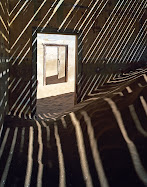 Fern Frond
Fern FrondThe structure of living things fascinates me. The great natural philosopher Robert Hooke noted in the 17th century how when you studied man made objects through a lens the structure became cruder the higher the magnification, whereas natural objects revealed finer and finer detail the more you magnified them. There is a deep beauty in natural forms.
Ferns are a particular favourite of mine because of the elegance and simplicity of the structure of each frond. Mathematicians have realised in the last thirty years that they can model infinitely complex structures by using simple equations repeated many times with the result from one fed back in as the variable in the next. The most famous of these fractal equations is probably the Mandelbrot set – something often dismissively used as a screen saver. The fern can be modeled using such a simple equation, great beauty arising from simplicity.
Kyriakos Kalorkoti is a professor of mathematics who also happens to be addicted to landscape photography and a producer of very fine images. I'm priveleged to know him and we have had many fascinating discussions about photography, reality and art. In an article on his website he writes about the old question of whether photography is Art (note the capitalisation!):
"Much effort has been expended by various critics on the question of whether photography is Art; i.e., can it be included in the growing set of work and activities that are labeled as Art (since there is no generally accepted a priory definition of Art). One of the objections is the fact that a photograph is an image of some existing physical reality (ignoring manipulations).This objection can only be entertained if we go with the facile view that material existence is somehow mundane and thus is of no particular interest to Art; put briefly the view seems partly to be that material existence is no rival to imagination and all that photography can do is to record it. In fact existence of any kind is deeply problematic and mysterious; the nature of material reality is by no means straightforward and is thus more than a fitting source for image making that aims at transformation and revelation."
I find myself so strongly in agreement with this insight!
Why do we praise representations from our imagination above those springing from reality? Photography is partly to blame for this. Before the discovery of the photographic process a large proportion of the effort of painters was applied to producing the most realistic rendition of the world possible on a canvass – that is not to say that the objects or subjects depicted existed but just that they looked as if they might. In other words Art strove to not only express the thoughts or emotions of the artist (or their patron!) but to do so in as "truthful" a way as possible. Making the image look "real" leant it weight as document. Along comes photography, a mechanical process that effortlessly produces images drawn from the stuff of reality. The painter's years of effort suddenly seemed for nought, how could they compete? A new direction was needed and what was left but to travel further into the realms of the imagination. That doesn't make the study of reality in photography invalid, it just makes it something that photography can do better than painting.

2 comments:
There is also a question as to whether when we (photographers) go out and photograph do we have the end result in mind - is it art we are creating?
In the case of a 'professional' photographer do we subvert our own instinct to create 'art' with something that is more likely to sell?
Perhaps this question is also connected with why it is difficult to sell photographic prints for the same value as those drawn or painted on canvas.
It may be the critics who dispute whether photography is art but what about the wider public who are no longer educated in 'art' per se. Is education, or the lack of, dumbing down the debate / awareness on art?
In my mind whether it's Art or not is about a number of different intentions; a wish to express ourselves; a wish to make others look at what we're looking at, to question its value, to marvel, to enjoy. It's not Art if it's purpose is merely to illustrate, if what is connoted by the image is dominated by what is denoted by it (to borrow the jargon of semiotics). So if when we view an image we only see a description of what is photographed it has failed in its aspiration to the status of Art. Of course, sadly, some viewers will never see more than what is described.
Economic realities certainly do come into play for some photographers and I think that this is reflected in the quality of their work. Others try and describe their work as Art for economic reasons, sometimes without much justification. In fact I think quite a lot of the debate about whether photography is Art is actually motivated by economics.
There has been a sharp divide for many years between what an "artist as photographer" can expect for a print compared to a "photographer as artist". The former might reasonably expect a couple of orders of magnitude more for an image. Partly this is because he knows how to play the gallery system. There is a definite jealousy amongst some photographers resulting from this inequality (perhaps more strongly felt because the images seem to many to be less interesting!).
As to what the wider public understand Art is I can only recommend that you read "The Art Question" by Nigel Warburton.
Post a Comment